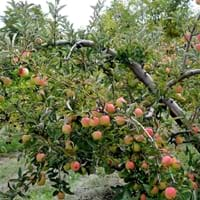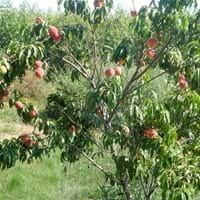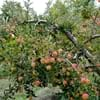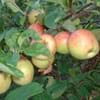Life Span
Perennial
Perennial
Origin
Eastern Europe, Southern Europe, Russia/Siberia, Southern Asia, Western Asia
China
Types
fuji, jonathan apple
Tuscany, Royal Gem, Flavortop, Crimson Baby, Fantasia
Number of Varieties
Not Available
Habitat
Cold Regions, gardens
Warmer regions
USDA Hardiness Zone
3-8
5-9
Sunset Zone
1a, 1b, 2a, 2b, 3a, 3b, 6, 7, 14, 15, 16
H1, 1a, 1b, 2a, 2b, 3a, 3b, 6, 7, 8, 9, 10, 11, 12, 13, 14, 15, 16, 18, 19, 20, 21, 22, 23, 24
Habit
Oval or Rounded
Oval or Rounded
Flower Color
White, Pink
White, Red, Light Pink, Rose
Flower Color Modifier
Bicolor
Bicolor
Fruit Color
Red, Yellow green
White, Yellow, Red, Pink, Peach
Leaf Color in Spring
Green
Green
Leaf Color in Summer
Green
Green
Leaf Color in Fall
Green, Light Yellow, Brown
Green
Leaf Color in Winter
Light Green
Light Green
Leaf Shape
Oval Cordate
Long, simple, curved and folded
Plant Season
Spring, Fall
Spring
Sunlight
Full Sun, Partial Sun, Partial shade
Full Sun
Growth Rate
Medium
Medium
Type of Soil
Clay, Loam, Sand
Loam, Sand
The pH of Soil
Acidic, Neutral
Acidic, Neutral
Soil Drainage
Well drained
Well drained
Bloom Time
Early Spring, Spring
Spring
Tolerances
Drought
Drought
Where to Plant?
Ground
Ground
How to Plant?
Grafting, Seedlings, Stem Planting
Budding, Grafting, Seedlings
Plant Maintenance
Medium
Medium
Watering Requirements
Do not water frequently
Average Water Needs, Requires regular watering
In Summer
Lots of watering
Lots of watering
In Spring
Moderate
Moderate
In Winter
Average Water
Average Water
Soil pH
Acidic, Neutral
Acidic, Neutral
Soil Type
Clay, Loam, Sand
Loam, Sand
Soil Drainage Capacity
Well drained
Well drained
Sun Exposure
Full Sun, Partial Sun, Partial shade
Full Sun
Pruning
Prune central stem, Remove lateral branches
Remove damaged leaves, Remove dead branches, Remove dead leaves
Fertilizers
Apply 10-10-10 amount, fertilize in growing season, Fertilize the soil before planting
All-Purpose Liquid Fertilizer
Pests and Diseases
Bacterial Blight, Bacterial Canker, Leaf rust, Red blotch, Ring Rot, Woodpecker feeding
Red blotch
Plant Tolerance
Drought
Drought
Flower Petal Number
Single
Single
Fragrant Flower
Yes
Insignificant
Foliage Texture
Medium
Medium
Foliage Sheen
Matte
Glossy
Attracts
Bees, Butterflies, Hummingbirds, Insects
Bees, Hummingbirds, Insects
Allergy
Peripheral Edema, Vomiting
Anaphylaxis, Asthma, Bronchial-constrictions, Food Allergy, Urticaria
Aesthetic Uses
Cottage Garden, Showy Purposes
Beautification
Beauty Benefits
Acne, For treating wrinkles, Improve skin tone, Moisturizing, Stops hair loss
Good for skin, Making cosmetics
Environmental Uses
Food for animals, Shadow Tree, soil stabilisation, Windbreak
Air purification
Medicinal Uses
Acne, Alzheimer’s Disease, Anemia, constipation, Gastrointestinal disorders, Hair Loss, Parkinson
Aphrodisiac, Blood stasis and neurodegenerative diseases, Cancer, cholesterol-lowering, Combats Stress, Culinary Usage, Diuretic, Hair Loss, Hypokalemia, Obesity, Skin Disorders, Stomach pain, Weight loss
Part of Plant Used
Fruits
Bark, Flowers, Leaves, Seeds
Other Uses
Acts as a natural source of rain water for birds and insects., Cosmetics, Used As Food
For making oil, Gum, Used as a dye, Used as Ornamental plant
Used As Indoor Plant
No
No
Used As Outdoor Plant
Yes
Yes
Garden Design
Edible, Fruit / Fruit Tree
Container, Fruit / Fruit Tree, Topiary / Bonsai / Espalier
Botanical Name
MALUS domestica 'Northern Spy'
PRUNUS persica nectarine
Common Name
Apple, Cider Apple, Cooking Apple, Eating Apple, Northern Spy Apple
Nectarine, Hardy Red
In Hindi
Northern Spy Apple
आड़ू
In German
Northern Spy Apfel
Dwarf Nectarine
In French
Northern Spy Pomme
Dwarf Nectarine
In Spanish
Espía del Norte de Apple
Dwarf Nectarine
In Greek
Βόρεια κατάσκοπος της Apple
Dwarf Nectarine
In Portuguese
Northern Spy a Apple
Dwarf Nectarine
In Polish
Northern Spy Jabłko
Dwarf Nectarine
In Latin
Northern Spy Apple
Hardy Red
Phylum
Magnoliophyta
Magnoliophyta
Class
Magnoliopsida
Magnoliopsida
Clade
Dicotyledonous, Rosids
Angiosperms, Eudicots, Rosids
Tribe
Not Available
Not Available
Subfamily
Not Available
Not Available
Number of Species
Not Available
Not Available
Importance of Northern Spy Apple and Dwarf Nectarine
Want to have the most appropriate plant for your garden? You might want to know the importance of Northern Spy Apple and Dwarf Nectarine. Basically, these two plants vary in many aspects. Compare Northern Spy Apple and Dwarf Nectarine as they differ in many characteristics such as their life, care, benefits, facts, etc. Every gardener must at least have the slightest clue about the plants he wants to plant in his garden. Compare their benefits, which differ in many ways like facts and uses. The medicinal use of Northern Spy Apple is Acne, Alzheimer’s Disease, Anemia, constipation, Gastrointestinal disorders, Hair Loss and Parkinson whereas of Dwarf Nectarine is Aphrodisiac, Blood stasis and neurodegenerative diseases, Cancer, cholesterol-lowering, Combats Stress, Culinary Usage, Diuretic, Hair Loss, Hypokalemia, Obesity, Skin Disorders, Stomach pain and Weight loss. Northern Spy Apple has beauty benefits as follows: Acne, For treating wrinkles, Improve skin tone, Moisturizing and Stops hair loss while Dwarf Nectarine has beauty benefits as follows: Acne, For treating wrinkles, Improve skin tone, Moisturizing and Stops hair loss.
Compare Facts of Northern Spy Apple vs Dwarf Nectarine
How to choose the best garden plant for your garden depending upon its facts? Here garden plant comparison will help you to solve this query. Compare the facts of Northern Spy Apple vs Dwarf Nectarine and know which one to choose. As garden plants have benefits and other uses, allergy is also a major drawback of plants for some people. Allergic reactions of Northern Spy Apple are Peripheral Edema and Vomiting whereas of Dwarf Nectarine have Anaphylaxis, Asthma, Bronchial-constrictions, Food Allergy and Urticaria respectively. Having a fruit bearing plant in your garden can be a plus point of your garden. Northern Spy Apple has showy fruits and Dwarf Nectarine has showy fruits. Also Northern Spy Apple is not flowering and Dwarf Nectarine is not flowering . You can compare Northern Spy Apple and Dwarf Nectarine facts and facts of other plants too.





